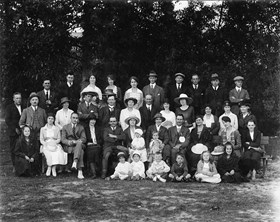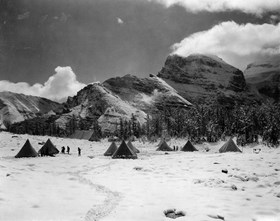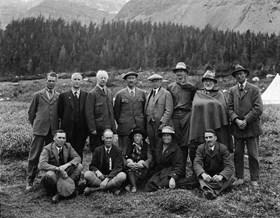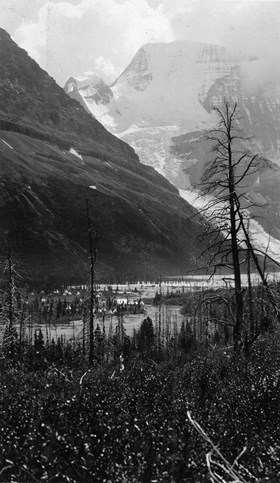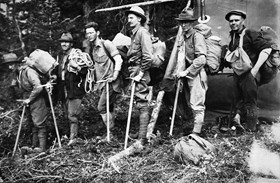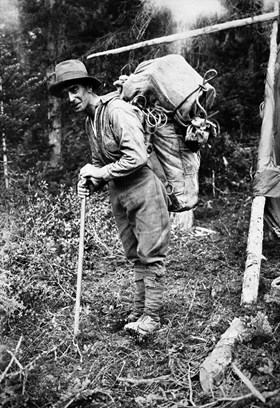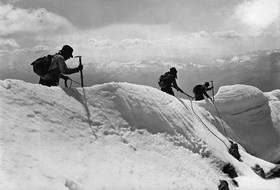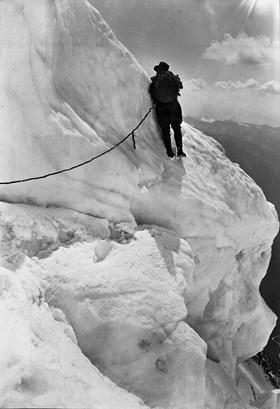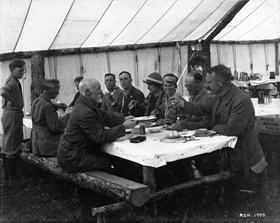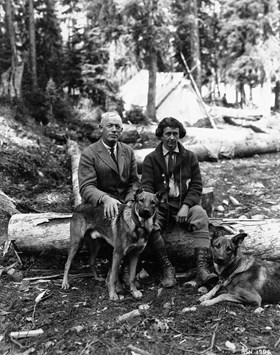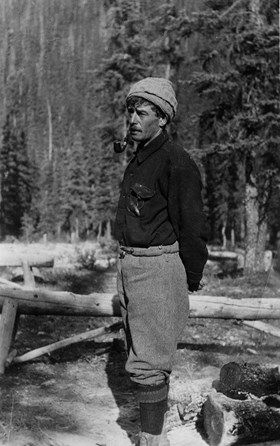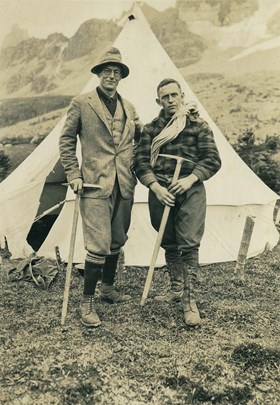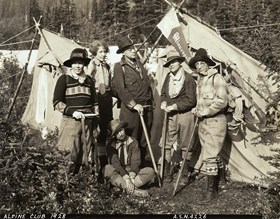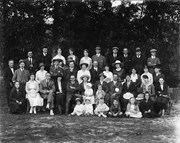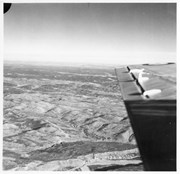Narrow Results By
- Peter and Catharine Whyte fonds 32
- Alpine Club of Canada fonds 22
- Jimmy Simpson family fonds 6
- Leonard Leacock fonds 6
- Luxton family fonds 6
- Underwood and Underwood Publishers fonds 5
- Byron Harmon fonds 4
- Caroline Hinman fonds 4
- Jim Brewster family fonds 3
- Canadian Pacific Railway fonds 2
- Parks Canada fonds 2
- Arthur Oliver Wheeler fonds 1
Photographic Paper
https://archives.whyte.org/en/permalink/artifact104.41.0224
- Date
- 1922
- Material
- cardboard; paper;
- Catalogue Number
- 104.41.0224
- Description
- A heavy beige box of photographic paper. The box is plain with little branding, one label on the top and a label along one side that connects to the bottom of the box. The label on the lid is black text in a square, it reads “OPEN ONLY IN PHOTOGRAPHIC DARK ROOM SENSITIZED PAPER”, a black line, and …
1 image
- Title
- Photographic Paper
- Date
- 1922
- Material
- cardboard; paper;
- Dimensions
- 9.2 x 18.7 x 15.5 cm
- Description
- A heavy beige box of photographic paper. The box is plain with little branding, one label on the top and a label along one side that connects to the bottom of the box. The label on the lid is black text in a square, it reads “OPEN ONLY IN PHOTOGRAPHIC DARK ROOM SENSITIZED PAPER”, a black line, and “Manufactured by Canadian Kodak Co., Limited TORONTO, CANADA”. The other label is coloured with a white background, blue banner, and green text which reads “GLOSSY DOUBLE WEIGHT 500 POST CARDS AZO F No. 4”. In the blue banner with a black border in white text reads “No. 4 FOR EXTREMELY FLAT NEGATIVES”. There is a stamped text that reads “EXPIRES JULY 1, 1922”. The bottom part of the label that is on the bottom of the box reads “500 POST CARDS AZO F No. 4 GLOSSY DOUBLE WEIGHT”. The bottom of the box features so handwriting and a stamped text that reads “5510 7034 46”. Inside the box is lots of post card photographic paper, some is wrapped in black paper.
- Credit
- Gift of L. A. E Duncan, Calgary, 1980
- Catalogue Number
- 104.41.0224
Images
This material is presented as originally created; it may contain outdated cultural descriptions and
potentially offensive content.
Read more.
Photographic Paper
https://archives.whyte.org/en/permalink/artifact104.41.0239
- Date
- 1923
- Material
- paper
- Catalogue Number
- 104.41.0239
- Description
- An unopened package envelope of Darko Developing Paper. On the front of the envelope is a green label with stylized text in red and darker green. The text on the label reads “MEDIUM EMULSION” (darker green) “OPEN ONLY IN VERY SUBDUED LIGHT” (red) “DARKO DEVELOPING PAPER” (red text with green outlin…
1 image
- Title
- Photographic Paper
- Date
- 1923
- Material
- paper
- Dimensions
- 14.6 x 19.6 cm
- Description
- An unopened package envelope of Darko Developing Paper. On the front of the envelope is a green label with stylized text in red and darker green. The text on the label reads “MEDIUM EMULSION” (darker green) “OPEN ONLY IN VERY SUBDUED LIGHT” (red) “DARKO DEVELOPING PAPER” (red text with green outlines) “EXTREMELY SENSITIVE” (darker green) “DIRECTIONS ENCLOSED” (red) “GLOSSY SURFACE” (darker green). Across the label is a black outlined text that reads “IMPROVED”. Stamped on the front is “1 Doz. 5x7” and on the back stamped “EXPIRATION DATE JUL 1 1923 3” “EMULSION NUMBER 8595 SORTED BY INSPECTED BY” “SEALED BY 4”.
- Credit
- Gift of L. A. E Duncan, Calgary, 1980
- Catalogue Number
- 104.41.0239
Images
This material is presented as originally created; it may contain outdated cultural descriptions and
potentially offensive content.
Read more.
- Date
- c. 1930
- Material
- paper; plastic;
- Catalogue Number
- 104.41.0246
- Description
- A small black plastic camera, Univex Model A, in its original box with information sheet. The box is bright orange with black text and stripes along the box. Front of the box has an illustration of the camera in the top middle, with text surrounding that reads “UNIVEX PICTURES MAKE” “BEAUTIFUL ENLA…
1 image
- Title
- Camera
- Date
- c. 1930
- Material
- paper; plastic;
- Dimensions
- 6.6 x 9.1 x 5.0 cm
- Description
- A small black plastic camera, Univex Model A, in its original box with information sheet. The box is bright orange with black text and stripes along the box. Front of the box has an illustration of the camera in the top middle, with text surrounding that reads “UNIVEX PICTURES MAKE” “BEAUTIFUL ENLARGEMENTS”. Underneath the illustration in cursive text “Univex” and in regular text “A JEWEL OF A CAMERA” and in the bottom black stripe, “UNIVERSAL CAMERA CORPORATION” “MADE IN U.S.A.” “NEW YORK, N.Y.”. This is the same on the opposite side. Along the shorter side is more text “MODEL A” “Univex” “CAMERA”, a stamp that reads “UNIVERSAL CAMERA COMPANY HERMANT BLOG. TORONTO, — CANADA”, and “MADE IN U.S.A.” The top and bottom of the box just read “MODEL A” “Univex” “CAMERA”. Inside the box is a small information sheet with pricing of rolls for the camera, printing and developing. The camera is small with a long square lens, a metal wire range finder that lines up with the smaller range finder attached to the side of the camera. The shutter is one the side of the lens, fairly small. There is a metal knob to wind the film. The back of the camera features raised text, “Univex” “USE UNIVEX No 00 FILM ROLLS ONLY” in a square, a red circle with “MADE IN UNITED STATES OF AMERICA”, “MODEL A CAMERA U.S. PAT. DES. 89.88 OTHER U.S. AND FOR’G’N PATSPOG” in a square, and “UNIVERSAL CAMERA CORPORATION NEW YORK, N.Y., U.S.A.”. The inside of the camera has a spot for film.
- Credit
- Gift of Don Harmon, Banff, 1985
- Catalogue Number
- 104.41.0246
Images
This material is presented as originally created; it may contain outdated cultural descriptions and
potentially offensive content.
Read more.
- Date
- 1920 – 1940
- Material
- metal; leather; plastic; celluloid
- Catalogue Number
- 104.41.0086 a-c
- Description
- Three black metal and leather “GRAFLEX CUT FILM MAGAZINE,” used to store individual celluloid negatives mounted into individual sleeves housed inside the main body. Access to the main body is possible by removing the the thin back panel with a leather strap that slides up alongside the leather bag …
1 image
- Title
- Film Magazines
- Date
- 1920 – 1940
- Material
- metal; leather; plastic; celluloid
- Dimensions
- 11.0 x 3.5 x 6.5 cm
- Description
- Three black metal and leather “GRAFLEX CUT FILM MAGAZINE,” used to store individual celluloid negatives mounted into individual sleeves housed inside the main body. Access to the main body is possible by removing the the thin back panel with a leather strap that slides up alongside the leather bag as well by pressing a button on the edge opposite the leather bag, allowing the front panel to pop open. On the front panel that can pop off is a small peephole accessible by a spring-hinged cover. Two of the magazines, marked with a red and a white strip of fabric, have the front panels taped closed with a small piece of masking tape.The three magazines are meant for different kinds of film. The one marked with a small strip of green fabric is meant for “KODAK EXTACOLOR Professional Type S (Short Exposure),” the one marked with the red fabric is meant for “KODAK EKTACHROME Film 6116, Type B (Process E-3),” and the one marked with the white fabric is meant for “KODAK TRI-X PAN SHEET FILM (ESTAR Thick Base).” The individual slides housed inside the magazine with the green fabric may have unprocessed fogged negatives still in them.
- Subject
- Nicholas Morant
- photography
- Kodak
- film photography
- photo developing
- Canadian Pacific Railway
- Credit
- Gift of Nicholas Morant, Banff, 2006
- Catalogue Number
- 104.41.0086 a-c
Images
This material is presented as originally created; it may contain outdated cultural descriptions and
potentially offensive content.
Read more.
- Date
- ca. 1926 – 1932
- Material
- metal; glass; leather; plastic
- Catalogue Number
- 104.41.0255 a,b
- Description
- A No.1A Pocket Kodak with camera case. a) Black camera with embellished details in the outer covering. On the top, there is a leather handle which reads “KODAK” and is attached to the camera with metal hinges. At the back of the camera is a red glass window. There is also a small opening with a tab…
1 image
- Title
- Folding Camera
- Date
- ca. 1926 – 1932
- Material
- metal; glass; leather; plastic
- Dimensions
- 20.9 x 8.7 x 3.7 cm
- Description
- A No.1A Pocket Kodak with camera case. a) Black camera with embellished details in the outer covering. On the top, there is a leather handle which reads “KODAK” and is attached to the camera with metal hinges. At the back of the camera is a red glass window. There is also a small opening with a tab that can slide open; this is an autographic window which would have allowed the photographer to add handwritten notes into the film negative with a stylus, which would have been included with the camera. There is a tab at the top of the camera that would be used for winding the film. On the back of the camera is an embellished logo reading “USE KODAK FILM No. A116” in a circular motif. The sides of the camera are rounded. On the front is a panel that opens by releasing the latch just above the panel. The front panel has a small hole in it with threads, suggesting that something could be screwed into it like a tripod. There is also a tripod hole on the bottom of the camera. On the outside of the front panel is a metal label with the text: “Kodak” written in embellished script. This label is a metal tab that folds out and operates as a stand for the camera to sit upright. On the back of the kickstand is engraved with the number “132743”. When opened, the inside of the panel door has a metal track. There is also metal hardware such as a screw mechanism that can be spun to move the metal track forward to adjust the viewing distance. On the right is a metal gauge with various distances in feet and meters. When the track is adjusted, a notch in the side of it lines up with the lines on the gauge. The panel door is attached with an elaborate brace that locks to keep the door in an open position. There is a metal knob that can be pulled forward to extend the lens and unfold the lens hood. The lens is connected with a metal frame. There are decorative labels attached to the lens frame. Above the lens is a label that reads: “KODEX” and has a logo reading “EKC” in an art deco font. The label also has shutter speeds. Beside the frame is the metal shutter release, which can be pushed down to activate the shutter. On the right is the viewfinder which can be viewed from above or the side by flipping it on its hinge. Small text below the lens reads: “SHUTTER MADE IN ROCHESTER, N.Y., U.S.A. BY”, “EASTMAN KODAK CO.” On the left side of this lower label are the numbers “29061”. There are also aperture settings along the bottom, which can be adjusted by moving the small arrow. Below the lens and its frames is another label which reads, “NO. 1A POCKET KODAK”; “MADE IN CANADA BY”; “CANADIAN KODAK CO.”; “LIMITED”; “TORONTO ONTARIO”. The lens is extended outward by press a small metal button next to the right side of the lens while using the small silver knob to guide. Outside, on the front of the camera, the metal hardware below the panel door can be lifted to release the entire interior cartridge in order to load film into the camera. The interior back panel is plastic and has a series of patent dates and patent numbers for USA, Canada, Australia, and Britain.b) A medium sized dark brown leather camera bag with a short strap with one metal buckle. On the front of the bag is a metal clasp with “CKC” (Canadian Kodak Co., Limited logo) and a lever to release the clasp. Above the clasp is stamped with “MADE IN U.S.A.” 22.1 x 9.8 x 4.4 cm.
- Subject
- film photography
- photography
- Kodak
- camera
- Credit
- Gift of Elaine Maxwell, Banff, 1984
- Catalogue Number
- 104.41.0255 a,b
Images
This material is presented as originally created; it may contain outdated cultural descriptions and
potentially offensive content.
Read more.
Folding Camera
https://archives.whyte.org/en/permalink/artifact104.41.0283
- Date
- ca. 1928 – 1943
- Material
- metal; plastic;
- Catalogue Number
- 104.41.0283
- Description
- A black and silver hard-shelled folding camera. On one end of the camera is a nylon(?) handle attached via to metal rings. The front of the camera is indicated by the metal stand for when the camera is open and a hole for a tripod. The front panel open with a small metal button on the left side, ne…
1 image
- Title
- Folding Camera
- Date
- ca. 1928 – 1943
- Material
- metal; plastic;
- Dimensions
- 18.0 x 8.3 cm
- Description
- A black and silver hard-shelled folding camera. On one end of the camera is a nylon(?) handle attached via to metal rings. The front of the camera is indicated by the metal stand for when the camera is open and a hole for a tripod. The front panel open with a small metal button on the left side, near the ‘key’ that winds the film. When opened the camera is attached to end of the front panel and fully extended with black bellows, there are no tracks for the camera to extend or retract on. On the right side of the lens is a viewfinder, that can be pushed from side to side for portrait or landscape. Along the lens is marked with aperture stops along the top of the lens and bottom, along with shutter speeds. The shutter release is on the left side of the lens. “PLENAX” in a red square is underneath the lens. A metal plate underneath the lens, on the front panel reads “PD 16 PLENAX” “USE PD 16 AGFA FILM” “MADE BY” “AFGA ANSCO CORPORATION” “BINGHAMTON, N.Y. U.S.A.” Either side of the camera, it is metal with an art-deco style simple design with silver lines. To release the back of the camera to load the film, there is a metal bar under the handle that acts as a latch. Inside the camera is a red and yellow sticker that reads “USE PD 16” “Agfa” “FILM” “For half-size picture use the metal picture mask in back of camera under film” “For full-size pictures, use no mask under film and lift hinged mask on view finder so larger scene is included.” “PATENTS PENDING”. There are two red circles for view the film when the camera is closed. There is a direct view of the folded bellows and lens, including the metal picture mask. On the back of the back panel is two small circles, top one reads “OPEN ONLY” “No. 2” arrow “WHILE” “WINDING” and the bottom one reads “OPEN ONLY” “No. 1” arrow “WHILE” “WINDING”.
- Credit
- Gift of Catharine Robb Whyte, O. C., Banff, 1979
- Catalogue Number
- 104.41.0283
Images
This material is presented as originally created; it may contain outdated cultural descriptions and
potentially offensive content.
Read more.
Mounting Corners
https://archives.whyte.org/en/permalink/artifact104.41.0264%20a%2cb
- Date
- c. 1925
- Material
- paper;
- Catalogue Number
- 104.41.0264 a,b
- Description
- A pair of unopened packages of photo mounting corners by Engel. a) An envelope with an intricate label that features an illustration of a young girl holding a photo album with photos that have been mounted using mounting corners in the upper part of the envelope, surrounding the illustration is lot…
1 image
- Title
- Mounting Corners
- Date
- c. 1925
- Material
- paper;
- Dimensions
- 14.1 x 7.9 cm
- Description
- A pair of unopened packages of photo mounting corners by Engel. a) An envelope with an intricate label that features an illustration of a young girl holding a photo album with photos that have been mounted using mounting corners in the upper part of the envelope, surrounding the illustration is lots of text about the product some of the text reads “MOUNT YOUR PICTURES WITH” “Engel” (in cursive), “MOUNTING CORNERS” “Handy as a Stamp” “Reg. U.S. PAT. OFF.” “THIS IS THE WAY THEY LOOK IN YOUR ALBUM” “QUICK — EASY — ARTISTIC” “PATENTED” “KNOWN THE WORLD OVER AS” “ “Art Corners” ” “NO PASTE NEEDED — NO MUSS — NO FUSS”. There is some text with instructions and prices at the bottom. On the back of the envelope is more text, including the different styles of the mounting corners and directions. b) An envelope with an intricate label that features a small illustration of a young girl holding a photo album with photos that have been mounted using mounting corners in the upper part of the envelope, it is surrounded by other illustrations of photos in the top corners, and an opened photo album. Surrounding the illustrations is lots of text about the product some of the text reads, “To Hold — To Safely Keep” PHOTO PRINTS, POST CARDS ETC., USE” “FOUR SQUARE” “Engel” “ “Art Corners” ”. There is some text with instructions and prices at the bottom. On the back of the envelope is more text, including different colours and illustrations of two different photos. 14.0 x 7.9 cm.
- Subject
- photography
- photography accessory
- Moore
- Credit
- Gift of Pearl Evelyn Moore, Banff, 1977
- Catalogue Number
- 104.41.0264 a,b
Images
This material is presented as originally created; it may contain outdated cultural descriptions and
potentially offensive content.
Read more.
- Date
- 1920 – 1960
- Material
- metal; fabric;
- Catalogue Number
- 102.05.0123 a-d
- Description
- Four heavy-duty black metal spotlights consisting of a round body containing the light bulb and fronted by a clear beveled crystal, a rectangular box extends from one side of the body and houses the power switch and cable, on the side opposite the power box is a handle, and a Y-shaped support stand…
1 image
- Title
- Spot Lights
- Date
- 1920 – 1960
- Material
- metal; fabric;
- Dimensions
- 168.5 x 42.4 x 43.5 cm
- Description
- Four heavy-duty black metal spotlights consisting of a round body containing the light bulb and fronted by a clear beveled crystal, a rectangular box extends from one side of the body and houses the power switch and cable, on the side opposite the power box is a handle, and a Y-shaped support stand attached to the sides of the body. The power cable is thick heavy-duty rubber. On the diamond-shaped knobs that hold the Y support in place is a logo of a stylized R and M inside a circle - a metal plaque fixed to the rectangular box near the crystal contains the manufacturer and patent details.
- Credit
- Gift of Nicholas Morant, Banff, 2006
- Catalogue Number
- 102.05.0123 a-d
Images
This material is presented as originally created; it may contain outdated cultural descriptions and
potentially offensive content.
Read more.
A. W. Drinnan photographs
https://archives.whyte.org/en/permalink/descriptions7237
- Part Of
- Alpine Club of Canada fonds
- Scope & Content
- Album and loose accompanying prints pertain to alpine club camps and activities.
- Date Range
- [ca. 1917-1928]
- Reference Code
- V14 / AC 192P / 01-10
- Description Level
- 5 / File
- GMD
- Photograph
- Photograph print
21 images
- Part Of
- Alpine Club of Canada fonds
- Description Level
- 5 / File
- Fonds Number
- M200 / S6 / V14
- Series
- III. Personal papers and photographs
- Sous-Fonds
- V14
- Accession Number
- 5200
- Reference Code
- V14 / AC 192P / 01-10
- Responsibility
- Album was assembled by A.W. Drinnan; includes many views by H. Pollard.
- Date Range
- [ca. 1917-1928]
- Physical Description
- 1 photograph album (ca.180 prints). -- 9 photographs : prints
- Scope & Content
- Album and loose accompanying prints pertain to alpine club camps and activities.
- Name Access
- Alpine Club of Canada
- Drinnan, A. W.
- Subject Access
- Abbot Pass Hut
- Activities
- Administration
- Advertising
- Alpine Club of Canada
- Alpine Club House
- Cabins
- Cabins and shelters
- Camps
- Club
- Competition
- Discovery and exploration
- Environment
- Environment and Nature
- Exploration
- Guide
- Guides
- Hiking
- Huts
- Mountain
- Mountain guides
- Mountaineering
- Mountaineers
- Mountains
- National parks and reserves
- Organizations
- Photography
- Scenery
- Sports and recreation
- Summit
- Geographic Access
- Banff National Park
- Jasper National Park
- Yoho National Park
- Alberta
- British Columbia
- Canada
- Language
- English
- Title Source
- Title based on album
- Processing Status
- Processed
Images
This material is presented as originally created; it may contain outdated cultural descriptions and
potentially offensive content.
Read more.
Badland landscape
https://archives.whyte.org/en/permalink/descriptions52083
- Part Of
- Peter and Catharine Whyte fonds
- Scope & Content
- Image of aerial view of Badlands - airplane wing visible at right
- Date Range
- [ca. 1926-1950]
- Reference Code
- V683 / III / A / 3 / PA - 304
- Description Level
- 6 / Item
- GMD
- Photograph
1 image
- Part Of
- Peter and Catharine Whyte fonds
- Description Level
- 6 / Item
- Fonds Number
- M36 / V683 / S37
- Series
- V683 / III / A / 3 : Peter and Catharine Whyte: Various Views of Banff and Area
- Sous-Fonds
- V683
- Accession Number
- .
- Reference Code
- V683 / III / A / 3 / PA - 304
- GMD
- Photograph
- Date Range
- [ca. 1926-1950]
- Physical Description
- Photograph: 1 print ; b&w.
- Scope & Content
- Image of aerial view of Badlands - airplane wing visible at right
- Subject Access
- Airplanes
- Aerial photography
- Badlands
- Geographic Access
- Alberta
- Language
- English
- Title Source
- Title based on item
- Processing Status
- Processed
Images
This material is presented as originally created; it may contain outdated cultural descriptions and
potentially offensive content.
Read more.

















